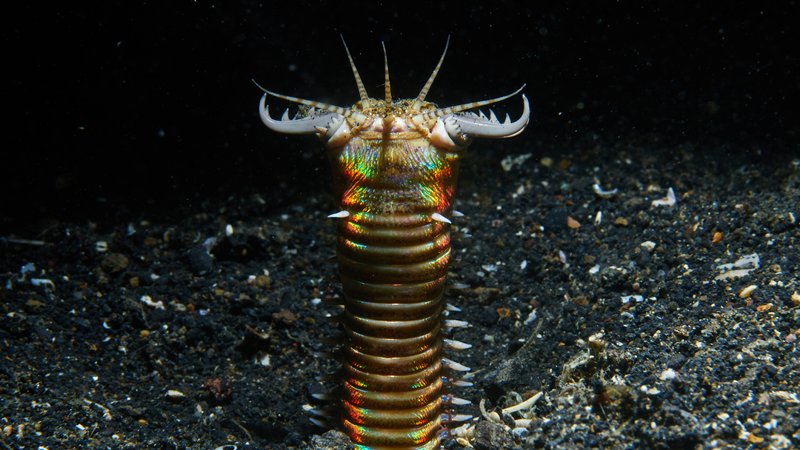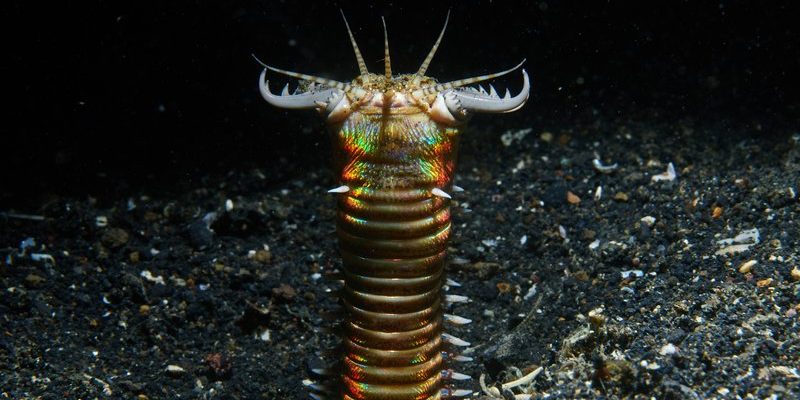
Let’s dive into how these worms hunt. It’s a mix of biology, physics, and a touch of drama that could rival any nature documentary. Strap in as we uncover the mechanics behind their swift strikes and what makes them such effective hunters.
Understanding Bobbit Worms
Bobbit worms, belonging to the family Eunicidae, can grow up to 10 feet long! They primarily reside in sandy or muddy substrates on the ocean floor. With their vibrant colors—ranging from green to red to brown—they blend into their surroundings, making it hard for unsuspecting prey to spot them. These worms are skilled ambush predators, using their burrowing abilities to create a safe haven while remaining hidden from view.
What’s particularly interesting about bobbit worms is their head. They possess a pair of long, curved jaws that can snap shut with incredible speed. This jaw structure is more than just for show; it’s a critical part of their hunting strategy. When prey swims too close, they exploit their stealth and lightning-fast reflexes to catch a meal.
The Art of the Ambush
Bobbit worms are patient hunters. They sit in their burrows, only exposing their segmented bodies and those fierce jaws. They often wait for hours, even days, for the perfect moment to strike. Here’s the thing: they rely heavily on movement detection. When they sense vibrations in the water, they spring into action.
Imagine you’re at a restaurant, waiting for your favorite dish to arrive. You’re patient, right? Now, picture that anticipation turning into a quick, decisive action the moment you see your dish at the other table. Bobbit worms do something similar, but their meal might be a fish or an unsuspecting crustacean.
Jaw Mechanics: How They Strike
The bobbit worm’s jaws are a fierce engineering feat. Unlike a typical jaw, which moves from top to bottom, these jaws work in a scissor-like motion. This unique design allows them to snap shut powerfully and quickly.
When they strike, their jaws can move at speeds reaching up to 0.5 meters per second—that’s about 1.6 feet! To put that into perspective, if you’re trying to catch a football thrown at you, you might need some quick reflexes. Bobbit worms take that to another level, catching their prey in a split second.
This fast movement isn’t just for show; it’s essential. The ocean is home to many swift and agile creatures. If bobbit worms want to secure a meal, they need to act fast.
The Mechanics of Speed: What Makes It Possible
Have you ever wondered what allows these worms to snap their jaws so quickly? It boils down to their muscle structure and the way their bodies are built. Bobbit worms have muscles that can contract rapidly, giving them explosive power when they need it.
Interestingly, their jaws also have a special feature. They’re lined with sharp teeth that can help grip prey, preventing escape. It’s like having an incredibly sharp set of scissors designed specifically for tearing through flesh and exoskeletons. Sounds intense, right?
This combination of muscle speed and jaw strength makes bobbit worms one of the ocean’s most effective hunters. They’re not just fast; they’re also incredibly precise.
What Happens After the Strike?
Once a bobbit worm catches its prey, the real feast begins. They often drag meals back into their burrows. Here, they can safely consume their meal without the risk of being attacked themselves. They have a unique way of feeding, often swallowing prey whole or breaking it apart using their powerful jaws.
You might think, “Do they ever get hurt while eating?” Well, with their formidable jaws and keen instincts, bobbit worms generally don’t have to worry about predators. It’s a vicious cycle, but that’s the cruel reality of underwater life.
Bobbit Worms and Their Ecosystem
Bobbit worms play an essential role in their ecosystem. By keeping populations of smaller fish and crustaceans in check, they help maintain the balance of marine life. Their predatory habits ensure that no single species dominates the sandy ocean floor.
Moreover, they serve as prey for larger predators, like certain species of fish and other sea creatures. This relationship creates a web of life where everyone has a role to play. Their existence is a reminder of the intricate connections within the ocean’s ecosystem.
Why Bobbit Worms Matter
You might wonder why we should care about these slimy creatures. Well, for starters, they’re a critical part of marine biodiversity. By studying their hunting techniques, scientists gain insights into evolution and predation strategies, which can inform conservation efforts.
Additionally, understanding how these worms function can lead to advancements in biomimicry—designing technology that mimics nature’s best solutions. Imagine how their jaw mechanics might inspire new tools or technologies in fields like robotics!
In a way, bobbit worms are not just oddities of the ocean; they’re pivotal to our understanding of marine life and innovation.
In conclusion, bobbit worms are extraordinary hunters, showcasing nature’s brilliance in both speed and mechanics. Their unique jaw structure and ambush strategies make them stand out in the vast, competitive ocean landscape. By learning about these amazing creatures, we gain a better appreciation of the complex life that exists beneath the waves. Next time you’re by the ocean, take a moment to think about the hidden lives that thrive just beneath the surface.

